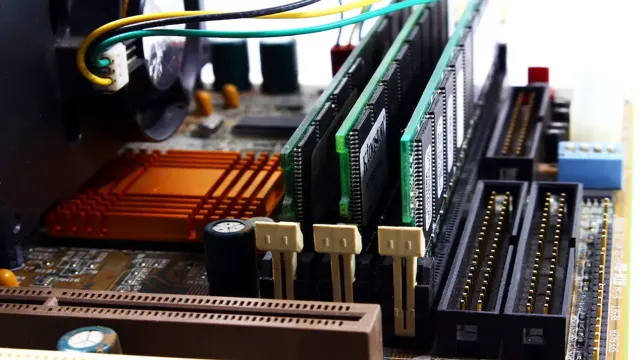Have you recently built or upgraded your computer and are now scratching your head wondering how to connect the power button to the motherboard? Fear not, for the process may seem daunting at first, but with a few simple steps, you’ll have your computer up and running in no time. The power button is an essential part of any computer, and without it, you won’t be able to turn on your machine. Connecting it to the motherboard might seem intimidating, but it’s a straightforward task that requires a little bit of patience and attention to detail.
In this blog post, we’ll take you through the step-by-step process of connecting the power button to the motherboard. We’ll break down every aspect of the process, making it easy for even the most novice builders to follow along. Whether you’re building your own computer or upgrading an existing one, knowing how to connect the power button properly is essential.
So, grab your motherboard manual, and let’s get started!
Locate the Power Button Connector
Connecting the power button to the motherboard can be a confusing process, but finding the power button connector is the first step. Typically, it is located near the front of the motherboard and can be identified by its small and rectangular shape. It is essential to refer to the motherboard manual to identify the exact location of the power button connector.
Once located, simply plug in the power button cable, ensuring that the positive and negative pins are correctly aligned with the corresponding pins on the motherboard. Incorrect installation may cause damage to the motherboard or the power button, and hence a lot of care and attention should be given while connecting them. So, take your time to locate and connect the power button correctly to prevent any motherboard malfunction.
Check the Motherboard Manual
When it comes to building a PC, locating the power button connector on the motherboard can be a challenge. Fortunately, most motherboards come with a manual that outlines the location of all the ports and connectors. The power button connector is usually labeled with “PWR_SW” on the motherboard, so keep a lookout for that.
Once you have located the connector, plug the power button cable into the corresponding pins. This cable is typically a two-pin connector that can be connected in any orientation. It’s important to ensure that the power button is connected correctly as it’s essential for turning on the PC.
Remember to double-check all of your connections before turning on your PC for the first time. By carefully following your motherboard’s manual, you’ll ensure that your PC build is successful, and your power button functions correctly.

Look for Power Pins
When building a computer, it’s important to find the power button connector to ensure your machine turns on and off correctly. One way to locate this connector is to look for power pins on your motherboard. These pins are small, metal prongs that are used to connect different components and are typically grouped together near the bottom or side of the board.
Most motherboards feature a two-pin power connector, although some may have a three-pin configuration. Once you’ve located the pins, you’ll need to refer to your motherboard’s manual to determine which pins correspond to the power button. From there, you can connect the power button connector by gently inserting it into the pins, aligning the positive and negative terminals as necessary.
So if you’re building a computer, be sure to look for power pins and locate the power button connector to ensure your machine operates smoothly.
Connect the Power Button Cable
If you’re building your own computer, one important task is correctly connecting the power button to the motherboard. The power button is what turns the computer on and off, so it’s a crucial component to get right. Connecting it can be a bit tricky, but thankfully it’s not too difficult.
The first step is to locate the power header on your motherboard – this is usually located near the bottom right-hand corner. Once you’ve found it, take the cable from your power button and connect it to the two pins on the power header. Be sure to read the motherboard manual to make sure you’re connecting it to the correct pins.
If it’s connected correctly, you should now be able to turn on your computer by pressing the power button. If the button doesn’t work, double-check your connections and try again. With a little patience and attention to detail, you’ll have your new computer up and running in no time!
Align the Pins
When it comes to building a PC, connecting the power button cable is an essential step that you don’t want to skip. To start, you will need to align the pins on the motherboard with the corresponding pins on the power button cable. This may seem like a simple task, but it’s important to do it correctly to ensure that your PC turns on properly.
Make sure that the pins are lined up correctly before gently pushing the cable onto the pins. It’s a good idea to double-check your work and make sure that the cable is securely connected before moving on to the next step in building your PC. By taking the time to properly connect the power button cable, you can avoid potential issues and keep your PC running smoothly.
Push the Cable In
When building a PC, it can be easy to overlook a small detail like properly connecting the power button cable. However, this is a crucial step in ensuring your PC turns on and operates correctly. One important thing to keep in mind is to push the cable in firmly.
Don’t be afraid to apply a bit of pressure to make sure it is securely plugged in. It’s also important to make sure you’re connecting it to the correct pins on the motherboard, as each motherboard is different. Taking the time to properly connect the power button cable can save you a headache in the long run, and ensure your PC runs smoothly.
So, take a deep breath, take your time, and make sure that power button cable is connected securely. Trust us, it’s worth it.
Ensure Firm Connection
When building a computer, ensuring a firm connection between components is crucial for optimal performance. One of the essential connections to make is the power button cable, which activates the power supply unit when pressed. To connect the power button cable, identify the pins labeled “PWR_SW” or “POWER SW” on the motherboard.
Then, locate the power button cable and attach it to these pins. It’s crucial to ensure that the connection is firm, as a loose connection can prevent the computer from turning on or pose a fire hazard. Think of the power button cable as the ignition key for your computer.
Just as you need a fully functional key to start your car, you need a secure connection for the power button cable to activate your computer’s power supply. Failing to ensure a firm connection can lead to frustration, delays, and even hardware damage. To ensure a secure connection, inspect the pins on the motherboard and the cable’s connectors.
Make sure they are free from debris or dust. Occasionally, the pins may become bent, and you can gently straighten them with a pair of needle-nose pliers. When attaching the cable to the pins, use a gentle but firm pressure to push them together.
In conclusion, connecting the power button cable is a vital step in building a computer. A firm connection ensures that your computer turns on without delay, runs optimally, and avoids any potential safety issues. Take the time to examine the pins and connectors and attach the cable securely, just as you would use your car’s ignition key with care to start the engine.
Test the Connection
Connecting the power button to the motherboard can be a bit daunting for beginners, but with a little guidance, it’s not too difficult. Once you’ve correctly hooked up the power switch cable to the pins on your motherboard, you’ll want to test the connection before buttoning everything up. To do this, simply press the power button on your case and see if your computer boots up.
If it doesn’t, you may have wired things incorrectly, but don’t panic. Double-check the cables and motherboard manual to make sure everything is where it should be. With a little tinkering, you’ll be well on your way to enjoying your newly built rig.
Don’t forget to give yourself a pat on the back for a job well done!
Turn On the Computer
Turning on the computer is a simple process, but before that, you need to test your connection. It can be frustrating to sit down to work or surf the internet only to find out that you have no connection. So, to avoid that, make sure to test your connection before anything else.
There are a few ways to do this, but the simplest way is to check your Wi-Fi or Ethernet connection. If you’re using Wi-Fi, check the signal strength and whether you’re connected to the right network. If you’re using an Ethernet connection, check the cable connection to make sure it’s plugged in properly.
You can also check your network settings to see if your computer is connecting to the internet. Once you’ve tested your connection and confirmed that everything is working, you can then turn on your computer.
Check If the Button Works
Testing the connection of a button on a webpage is crucial to ensure that it functions properly. You don’t want to have your visitors clicking a button that doesn’t work, leading to a negative user experience. To test the connection of your button, you can use different methods like clicking on the button and verifying if it leads to the correct page or performing a network analysis to check if the correct URL is being requested.
Another option is to use a tool like Google Analytics to track the click event and see if it’s registered properly. By testing the connection of your button, you can identify any issues and make sure that your visitors have a seamless experience on your website. So, take the time to test the connection of your buttons and ensure that they work as expected.
Your users will thank you for it!
Conclusion
Well, there you have it folks! Connecting the power button to the motherboard may seem like a daunting task, but the solution is as simple as connecting the dots. With just a few clicks and a little know-how, you’ll be powering up your computer in no time. So don’t be afraid to give it a go – you just might spark a new love for DIY computer repair.
Happy button pushing!”
FAQs
What is the purpose of the power button on a computer?
The power button is used to turn on and off the computer.
How do I connect the power button to the motherboard?
To connect the power button to the motherboard, you need to locate the power button header and plug in the two pins for the power button.
What should I do if my power button is not working?
If your power button is not working, you can try troubleshooting by checking the connections, replacing the button, or resetting the BIOS settings.
Can I use a different type of power button on the motherboard?
You should only use the recommended power button for your motherboard to ensure proper compatibility and functionality. Using a different type of power button could damage the motherboard or cause issues with power on/off functions.


